Similarity Measures, Distance Measures and Frequent itemsets
Ranked Retrieval¶
- Most users incapable of writing Boolean queries
- Boolean queries often result in either too few (=0) or too many (1000s) results.
- Rather than a set of documents satisfying a query expression, the system returns an ordering over the top documents in the collection
Scoring as basis for Ranked Retrieval¶
- A score measures how well document and query "match"
- Jaccard Coefficient
- \(jaccard(A,B) = |A ∩ B| / |A ∪ B|\)
- A and B don’t have to be the same size.
- Always assigns a number between 0 and 1.
- ISSUES
- It doesn’t consider term frequency
- Rare terms in a collection are more informative than frequent terms. Jaccard doesn’t consider this information.
- We need a more sophisticated way of normalising for length
- Bag of Words
- Vector representation doesn’t consider the ordering of words in a document
John is quicker than MaryandMary is quicker than Johnhave same vectors
- Term Frequency:
- The term frequency \(tf_{t,d}\) of term t in document d is defined as the number of times that t occurs in d
- We want to use tf when computing query-document match scores.
- We don't want to use Raw Term Frequency as Relevance does not increase proportionally with term frequency.
- Log Frequency Weighting:
- The log frequency weight of term t in d is defined as follows: \(tf\)-\(w_{t,d}\) aka \(\(w_{t,d} = 1 + log_{10}\ tf_{t,d}\ \ \ \ \ \ when\ tf_{t,d} > 0 \ \ ; otherwise \ 0\)\)
- Score for a document-query pair: sum over terms t in both q and d:\(\(score=\ \sum_{t\ ∈\ q\ \cap \ d} (1 \ + \ log_{10}\ tf_{t,d}\)\)
- Rare terms are more informative than frequent terms; We want a high weight for rare terms
- Inverse Document Frequency
- \(df_t\) is the document frequency of t: the number of documents that contain t
- We define the idf (inverse document frequency) of t by \(\(idf_t \ = \ log_{10}(N/df_t)\)\)
- We use log (N/dft) instead of N/dft to “dampen” the effect of idf.
- idf affects the ranking of documents for queries with at least 2 terms
- tf-idf weighting
- product of its tf weight and idf weight\(\(w_{t,d} = 1+log(tf_{t,d })\ * \ log_{10}(N/df_t)\)\)
- Best known weighting scheme in information retrieval
- Alternative names: tf.idf, tf x idf
- Increases with the number of occurrences within a document
- Increases with the rarity of the term in the collection
- Score for a document given a query:\(\(score(q,d)\ = \ \sum_{t\ ∈\ q\ \cap \ d}tf.idf_{t,d}\)\)
Queries as Vectors¶
- Key idea 1: Do the same for queries: represent them as vectors in the space
- Key idea 2: Rank documents according to their proximity to the query in this space
- proximity = similarity of vectors or proximity ≈ inverse of distance
- The reason we do this is to get away from the 'Feast or Famine' condition of Boolean model
- Instead: rank more relevant documents higher than less relevant documents
- Euclidean Distance
- bad idea -> it is large for vectors of different lengths
- The Euclidean distance between q and d2 is large even though the distribution of terms in the query q and the distribution of terms in the document d2 are very similar.
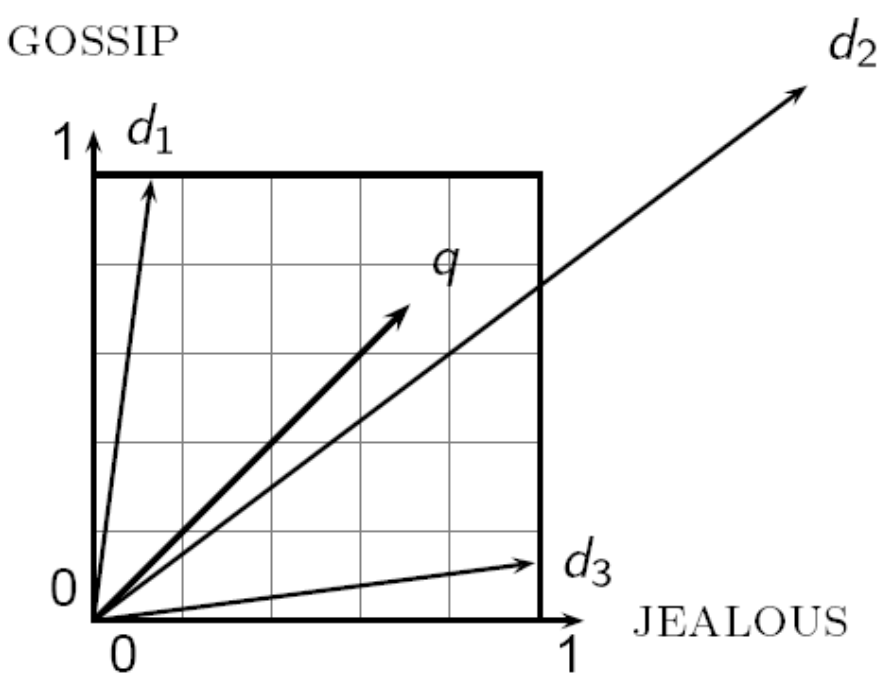
- From angles to Cosines
- Ranking documents in decreasing order of the angle between query and document is similar to ranking documents in increasing order of cosine(query, document)
- Cosine is a monotonically decreasing function for the interval [0\(\degree\) to 180\(\degree\)]
- Length Normalization
- \(||\vec{x}|| = \sqrt{\sum_i{x_i^2}}\)
- Dividing a vector by its L2 norm (above formula) makes it a unit (length) vector.
- cosine(query,document)
- \(q_i\) -> tf-idf weight of term i in the query
- \(d_i\) is tf-idf weight of term i in the document \(\(cos(\vec{q},\vec{d})\ = \ \frac{\sum_{i=1}^{|V|}q_id_i}{\sqrt{\sum_{i=1}^{|V|}q_i^2}\ \sqrt{\sum_{i=1}^{|V|}d_i^2}}\)\)
- For length-normalized vectors, cosine similarity is simply the dot product $$cos(\vec{q},\vec{d}) = \sum_{i=1}^{|V|}q_id_i $$for q, d length-normalized.
- calculating Length Normalized Values for a document \(\(lengthNormalisedValue_i = \frac{x_i}{\sqrt{x_0^2 + x_1^2.....+x_n^2 }}\)\)
- TF-IDF weighting Variants

Similarity Measuring Techniques¶
- Shingles
- k-shingle is defined to be any substring of length k found within the document.
- Assumption -> Documents that have lots of shingles in common have similar text, even if the text appears in different order
- You must pick k large enough, or most documents will have most shingles
- Generally value for k used irl is 7-10
- Min-Hashing
- Convert large sets to short signatures, while preserving similarity
- Many similarity problems can be formalized as finding subsets that have significant intersection
- \(d(C_1,C_2) = 1 - (Jaccard\ Similarity)\)
- Representing Sets as Boolean Matrices
- Rows -> elements (shingles)
- Columns -> sets(documents)
- Matrix Representation of Set
- A value 1 in row r and column c if the element for row r is a member of the set for column c
- Otherwise the value in position (r, c) is 0.
- Hashing Columns (Signatures)
- Key idea -> “hash” each column C to a small signature h(C), such that:
- (1) h(C) is small enough that the signature fits in RAM
- (2) sim(C1, C2) is the same as the “similarity” of signatures h(C1) and h(C2)
- Hash docs into buckets. Expect that “most” pairs of near duplicate docs hash into the same bucket!
- if sim(d1,d2) is high, then the P(H(d1) == H(d2)) is "high"else vice versa
- Key idea -> “hash” each column C to a small signature h(C), such that:
- Permutation
- Given the following 3 permutations and input matrix; you have to form the signature matrix
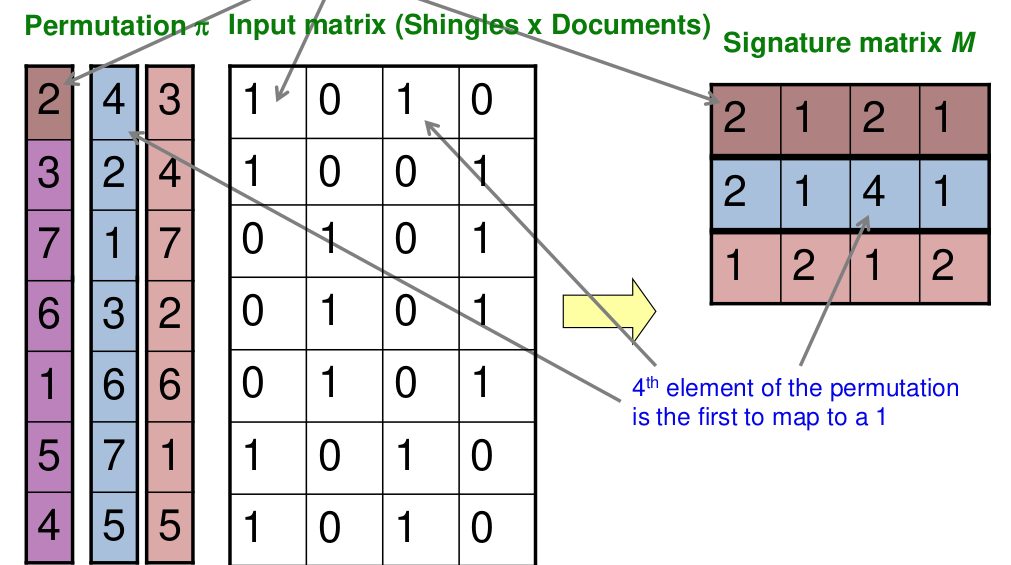
- the resultant signature matrix will always be in the form (no of permutations X no of documents (columns))
- fill in column by column i.e.
- find the first occurrence of 1-valued-bit in increasing order of values of the permutation ; repeat for each permutation
- For example, in the above row we find:
- first permutation; (number:value) 1:0, 2:1, 3:1.... we select 2 as it is the lowest occurring valid bit
- second permutation: 1:0, 2:1... we choose 2
- third permutation: 1 :1 ... we choose 1
- repeat above for all documents
- Given the following 3 permutations and input matrix; you have to form the signature matrix
- Locality Sensitive Hashing
- One general approach to LSH is to “hash” items several times, in such a way that similar items are more likely to be hashed to the same bucket than dissimilar items are
- Any pair that hashed to the same bucket for any of the hashings is termed to be a candidate pair
- Candidate pairs are the ones that hash to the same bucket
- • Divide the signature matrix Sig into b bands of r rows
- • Each band is a mini-signature with r hash functions.
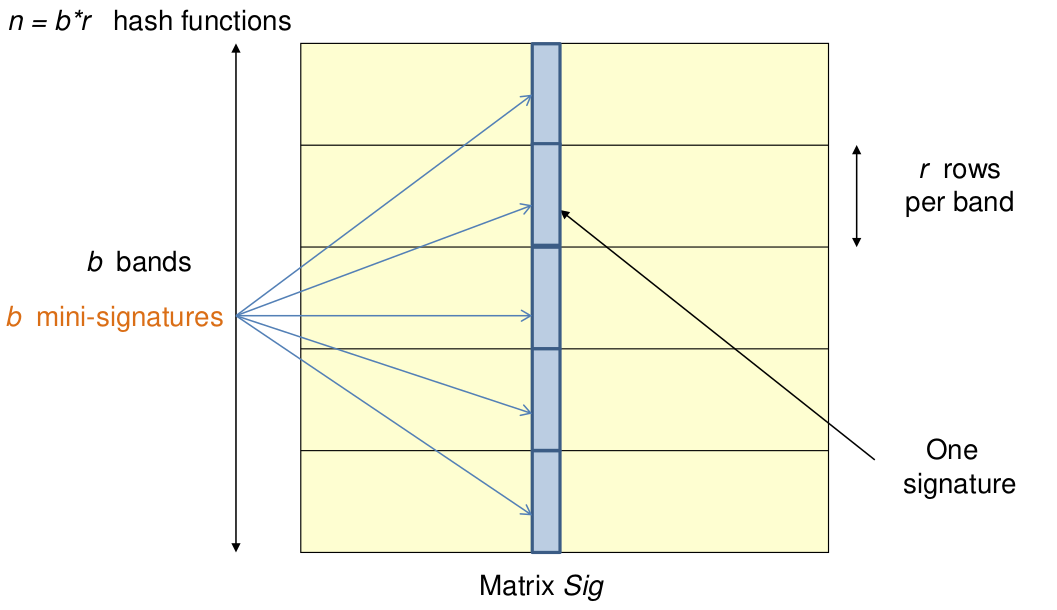
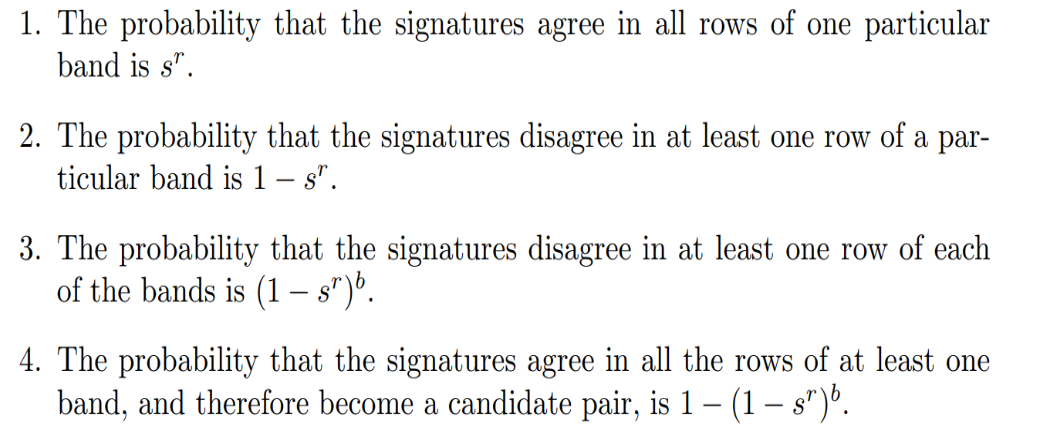
Minimum Edit Room¶
- Minimum number of editing operations needed to transform one string into the other
- Insertion
- Deletion
- Substitution
- Dynamic Programming solution, tabulation.
Frequent Itemset¶
- Itemset with count > minimum support count
- Support count (\(\sigma\)) = Frequency of an itemset
- Support -> Fraction of transactions that contain the itemset
- Association Rule
- Implication expression of the form X -> Y
- X and Y are itemsets.
- Implication expression of the form X -> Y
- Rule Evaluation Metrics
- Support(s)\(\(Support = \frac{\sigma(itemset)}{Total \ Number\ of \ Items}\)\)
- Confidence(c)
- Measures how often item Y appears in transactions that contain X\(\(Confidence(c)\ = \frac{X \cap Y}{X}\)\)
- Example, {Milk , Diaper } -> {Beer}\(\(Confidence = \frac{\sigma(Milk,Diaper,Beer)}{\sigma(Milk,Diaper)}\)\)
Approaches¶
- Bruteforce -> Computationally Prohibitive
- Total number of possible association rules: \(3^d - 2^{d+1} + 1\)
- Two-step approach
- Frequent item-set generation
- Generate all itemsets whose support > minsup
- Given d items, there are \(2^d\) possible candidate itemsets
- Rule Generation
- Generate high confidence rules from each frequent itemset, where each rule is a binary partitioning of a frequent itemset
- Frequent item-set generation
- Brute-force approach:
- Each itemset in the lattice is a candidate frequent itemset
- Count the support of each candidate by scanning the database
- Complexity O(NMW), Expensive! Since, \(M = 2^d\)
- Match every transaction against every other
- What can be done here then?
- Reduce the number of candidates (M) -> pruning techniques to be used
- Reduce the number of transactions(N) -> reduce size of N as itemset increases
- Reduce the number of comparisons (NM) -> Don't match every candidate with every transaction
- Apriori Principle
- If an itemset is frequent, then all of its subsets must also be frequent
- (anti-monotone property) Support of an itemset never exceeds the support of its subsets
- Apriori Algorithm:
- Fk: frequent k-itemsets
- Lk: candidate k-itemsets
- Candidate Generation
- Bruteforce -> 1 itemset with 1 itemset
- Merge \(F_{k-1}\) and \(F_1\) itemsets
- \(F_{k-1}\) x \(F_{k-1}\) Method
- Merge two frequent (k-1)-itemsets if their first (k-2) items are identical
- Alternative method Merge two frequent (k-1)-itemsets if the last (k-2) items of the first one is identical to the first (k-2) items of the second.
- Rule Generation
- Merge two frequent (k-1)-itemsets if the last (k-2) items of the first one is identical to the first (k-2) items of the second.
- But confidence of rules generated from the same itemset has an anti-monotone property\(\(c(ABC -> D) ≥ c(AB -> CD) ≥ c(A -> BCD)\)\)
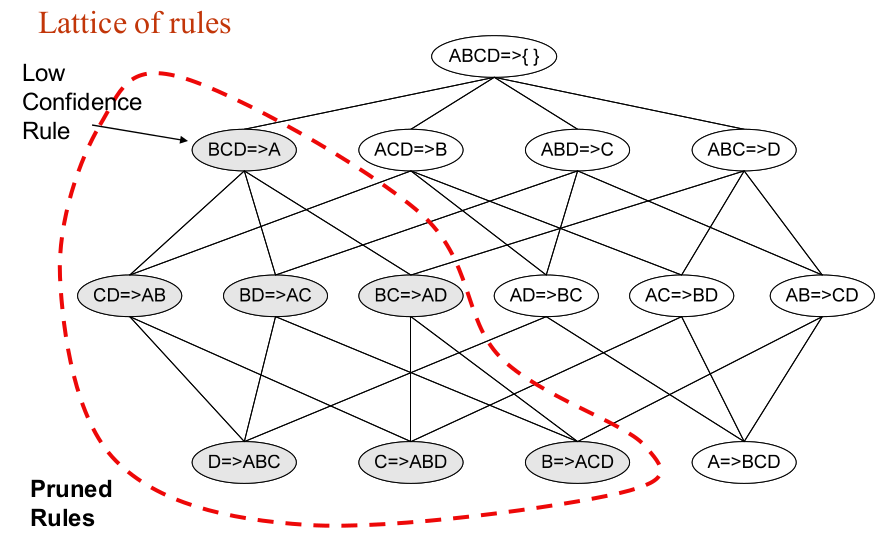
- Factors Affecting Complexity of Apriori
- Choice of minimum support threshold
- lowering support threshold results in more frequent itemsets
- this may increase number of candidates and max length of Frequent itemsets
- Dimensionality (number of items) of the data set
- More space is needed to store support count of itemsets
- if number of frequent itemsets also increases, both computation and I/O costs may also increase
- Size of database
- Run time of algo increases with DB Size
- Average transaction width
- transaction width increases the max length of frequent itemsets
- Choice of minimum support threshold
Maximal Frequent Itemset
- An itemset is maximal frequent if it is frequent and none of its immediate supersets is frequent
- In short 'bhai frequent hai, but bhai ki next generation se nahi ho paya!'
Closed Itemset
- An itemset X is closed if none of its immediate supersets has the same support as the itemset X.
- ' In short, beta baap se niche hi rahega, equal hua to nahi chalega'
- Relationship between the various frequent itemsets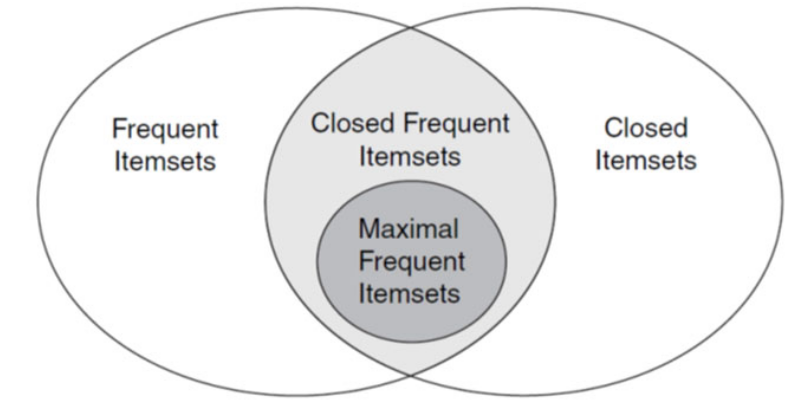
- Pattern Evaluation
- Association rule algorithms can produce large number of rules
- Interestingness measures can be used to prune/rank the patterns
- what kind of rules do we really want?
- Confidence(X -> Y) should be sufficiently high too ensure that people who buy X will more likely buy Y than not buy Y
- Confidence(X -> Y) > support(Y)
- Otherwise, rule will be misleading because having item X actually reduces the chance of having item Y in the same not buy Yin the same transaction!
Statistical Relationship between X and Y
- If P(X,Y) > P(X) * P(Y) : X & Y are positively correlated
- If P(X,Y) < P(X) * P(Y) : X & Y are negatively correlated
- P(X,Y) = P(X) * P(Y) (X and Y are independent)
Lift
- Used for rules \(\(Lift = \frac{P(Y|X)}{P(Y)}\)\)
Interest
- used for itemsets\(\(\frac{P(X,Y)}{P(X)P(Y)}\)\)
\(\(PS = P(X,Y) - P(X)P(Y)\)\)
Effect of Support Distribution
- If minsup is too high, we could miss itemsets involving interesting rare items
- If minsup is too low, it is computationally expensive and the number of itemsets is very large
A measure of Cross Support
- With n items, we can define a measure of cross support, r as
\(\(r(x) = \frac{min{s(x_1),s(x_2),..s(x_n)}}{max{s(x_1),s(x_2),..s(x_n)}}\)\)
- Can use \(r(x)\) to prune cross support patterns
- To avoid patterns whose items have very different support, define a new evaluation measure for itemsets